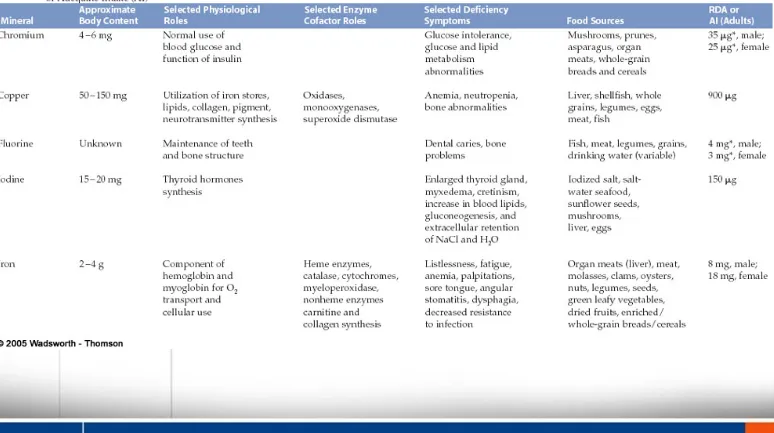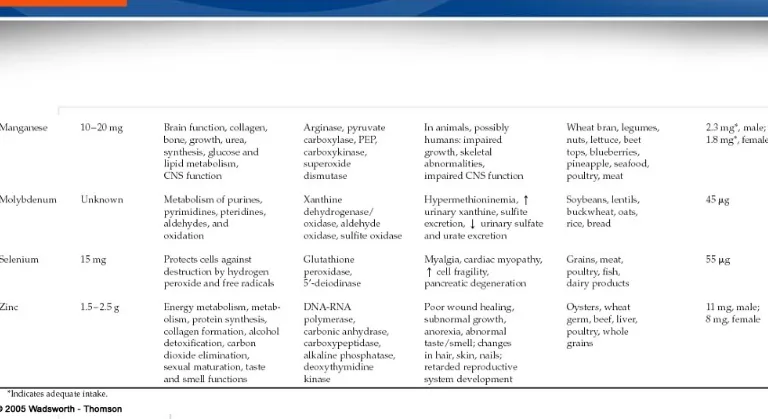PENGANTAR METABOLISME ZAT GIZI MIKRO PERTEMUAN 1
DUDUNG ANGKASA
VISI DAN MISI UNIVERSITAS ESA
UNGGUL
Materi Sebelum UTS
02. Vitamin A
07. Vitamins Interaction 03. Vitamin D
04. Vitamin E dan K
05. Vitamin Larut Air- C
Materi Setelah UTS
09. Mineral-Fe, Zn, I
14. Review
10. Mineral-Mn, Cr, Cl
11. Mineral-Co, Mo, Cu, F
12. Mineral Interactions
KEMAMPUAN AKHIR YANG
DIHARAPKAN
• Mahasiswa dapat menjelaskan metabolisme zat gizi mikro
Topik Perkuliahan (1/2)
TEMU Topik Bahasan
1
Why study the micronutrient
metabolism and what its relationship with other courses?
1. History of micronutrient problem 2. Night blindness, Anemia, Scurvy, IDD 3. Metabolism, diet and research
2 Fat-soluble vitamin-1
1. Vitamin A (digestion, absorption, storage and utilization)
2. Factors afecting the metabolism 3. Dietary Requirement and Toxicity
3 Fat-soluble vitamin-2
1. Vitamin D (digestion, absorption, storage and utilization)
2. Factors afecting the metabolism 3. Dietary Requirement and Toxicity
4 Fat-soluble vitamin-3
1. Vitamin E and K (digestion, absorption, storage and utilization)
2. Factors afecting the metabolism 3. Dietary Requirement and Toxicity
5 Water-soluble vitamin-1 1. Vitamin C (digestion, absorption, storage and utilization)
2. Factors afecting the metabolism 3. Dietary Requirement and Toxicity
6 Water-soluble vitamin-2
1.Vitamin B1, B2, B6, B12
2. Factors afecting the metabolism 3. Dietary Requirement and Toxicity
7 Water-soluble vitamin-3
1. Vitamin PP, pantothenic acid, folic acid, biotin, lipoic acid
2. Factors afecting the metabolism 3. Dietary Requirement and Toxicity
8 Vitamin-Vitamin Interaction Synergy vs Antagonist
TEMU Topik Bahasan
9 Mineral-1
1. Macro Mineral (Calsium, Mg, Na, K, P, S) (digestion, absorption, storage and
utilization)
2. Factors afecting the metabolism 3. Dietary Requirement and Toxicity
10 Mineral-2
1. Fe, Zn, I (digestion, absorption, storage and utilization)
2. Factors afecting the metabolism 3. Dietary Requirement and Toxicity
11 Mineral-3
1. Mn, Cr, Cl (digestion, absorption, storage and utilization)
2. Factors afecting the metabolism 3. Dietary Requirement and Toxicity
12 Mineral-4
1. Co, Mo, Cu, F (digestion, absorption, storage and utilization)
2. Factors afecting the metabolism 3. Dietary Requirement and Toxicity
13 Mineral-Mineral Interaction Synergy vs Antagonist
14 Vitamin-Mineral Interaction Synergy vs Antagonist
15 UJIAN Akhir Semester
Penilaian
•
Presensi
: 10%
•
Tugas Terstruktur : 30%
•
UTS
: 30%
Why do we study micronutrient?
History: 1. Scurvy 2. Beri-beri 3. Pellagra 4. Rickets
Abstract
Micronutrients are essential to sustain life and for optimal physiological function. Widespread global micronutrient deficiencies (MNDs) exist, with pregnant women and their children under 5 years at the highest risk. Iron, iodine, folate, vitamin A, and zinc deficiencies are the most widespread MNDs, and all these MNDs are common contributors to poor growth, intellectual impairments, perinatal complications, and increased risk of morbidity and mortality. Iron deficiency is the most common MND worldwide and leads to microcytic anemia, decreased capacity for work, as well as impaired immune and endocrine
function. Iodine deficiency disorder is also widespread and results in goiter, mental retardation, or reduced cognitive function. Adequate zinc is necessary for optimal immune function, and deficiency is associated with an increased incidence of diarrhea and acute respiratory infections, major causes of death in those <5 years of age. Folic acid taken in early pregnancy can prevent neural tube defects. Folate is essential for DNA synthesis and repair, and deficiency results in macrocytic anemia. Vitamin A deficiency is the leading cause of blindness worldwide and also impairs immune function and cell differentiation. Single MNDs rarely occur alone; often, multiple MNDs coexist. The long-term consequences of MNDs are not only seen at the individual level but also have deleterious impacts on the economic development and human capital at the country level. Perhaps of greatest concern is the cycle of MNDs that persists over generations and the intergenerational consequences of MNDs that we are only beginning to understand. Prevention of MNDs is critical and traditionally has been accomplished through supplementation,
fortification, and food-based approaches including diversification. It is widely accepted that intervention in the first 1,000 days is critical to break the cycle of malnutrition; however, a coordinated, sustainable
commitment to scaling up nutrition at the global level is still needed. Understanding the epidemiology of MNDs is critical to understand what intervention strategies will work best under different conditions.
Iron Deficiency
• A few salient facts (WHO, accessed 2017)
• In developing countries every second pregnant woman and
about 40% of preschool children are estimated to be anaemic.
• In many developing countries, iron deficiency anaemia is
aggravated by worm infections, malaria and other infectious diseases such as HIV and tuberculosis.
• The major health consequences include poor pregnancy
Iodine (CDC, accessed 2017)
• Iodine is one of the most important minerals required by a
fetus for brain and cognitive development, though the iodine content in most foods and beverages is low3.
• 18 million babies are born mentally impaired because of
maternal iodine deficiency and 38 million are born at risk of iodine deficiency9. Globally it is estimated that 2 billion
people have insufficient iodine intake10.
• Fortification of salt with iodine has been one of the most
successful nutrition interventions to date--71% of global households have access to iodized salt11.
• Salt iodization has led to an increase in IQ points and
Vitamin A (CDC, accessed 2017)
• Vitamin A is necessary to support healthy eyesight and
immune system functions; children who are deficient face an increased risk of blindness and death from infections such as measles and diarrhea7.
• Globally, 1 in 3 pre-school aged children and 1 in 6
pregnant women are vitamin A deficient due to inadequate dietary intake.7
• Vitamin A supplementation of children 6-59 months has
been shown to be highly effective in reducing mortality from all causes in countries where vitamin A deficiency is a
Vitamin A (WHO, accessed 2017)
• A few salient facts
• An estimated 250 million preschool children are vitamin A
deficient and it is likely that in vitamin A deficient areas a substantial proportion of pregnant women is vitamin A deficient.
• An estimated 250 000 to 500 000 vitamin A-deficient
Zinc (CDC, accessed 2017)
• Zinc is a mineral that promotes immunity, resistance to
infection, and proper growth and development of the nervous system3, and is integral to healthy pregnancy outcomes12
• 17.3% of the global population is at risk for zinc deficiency
due to dietary inadequacy, though up to 30% of people are at risk in some regions of the world12.
• Zinc supplementation reduces the incidence of premature
birth, decreases childhood diarrhea and respiratory
Folate (CDC, accessed 2017)
• Folate is a vitamin that is essential in the earliest days of
fetal growth for healthy development of the brain, spinal cord, and skull13
• Ensuring sufficient levels of folate in women prior to
conception can reduce neural tube defects (a serious birth defect) by up to 50%13
• Supplementations of women 15-49 years with folic acid,
MICRONUTRIENTS VERSUS MACRONUTRIENTS
vitamin
Definition
Vitamin Structure and Function
•
All vitamins contain carbon, hydrogen, and oxygen
– Some vitamins contain nitrogen and sulfur
•
Chemical structure of each vitamin is unique
•
Vitamins are absorbed intact
Classification of Vitamins
•
Classification is based on solubility
– Eight water-soluble: B vitamin complex and vitamin C – Four fat-soluble: vitamins A, D, E, and K
•
Solubility influences a vitamin’s
– Digestion – Absorption
– Transportation – Storage
Slide 24 of 27
Fat-soluble vitamins can be stored by the body
Fat-Soluble Vitamins
Sources of fat-soluble vitamins are vegetable oils
liver eggs
certain vegetables
Slide 26 of 27
Water-soluble vitamins cannot be stored by the body.
Water-Soluble Vitamins
Examples of water-soluble vitamins are C and all of the B vitamins.
Sources of water-soluble vitamins are fruits
vegetables
whole-grain foods
14
Essential Vitamins For Human Being
vitamins
water -soluble
lipid-soluble
Vit C
Vit B
A,D,E,K
Vitamin Absorption and Storage
•
All absorption takes place in the small intestine
•
Fat-soluble vitamins
– Are absorbed in the duodenum – Storage
• Vitamin A is mainly stored in the liver
• Vitamins K and E are partially stored in the liver
Vitamin Absorption and Storage
•
Water-soluble vitamins
– Absorbed with water and enter directly into the blood
stream
– Most absorbed in the duodenum and jejunum – Most are not stored in the body
– Excess intake excreted through the urine
Water-Soluble
Vitamins
Fat-Soluble
Vitamins
Absorbed in
the
Small Intestine Small Intestine
Hydrophobic or
Hydrophilic
Hydrophilic
Hydrophobic
Absorbed into
the
Blood
Lymph
Stored in the
body
Not Generally
Yes
Can build up
and become
toxic
Not Generally
Yes
Need to
Downloaded from: StudentConsult (on 28 September 2011 12:12 PM) © 2005 Elsevier
Bioavailability
•
Varies based on
– Amount in food – Preparation
– Efficiency of digestion and absorption of food – Individual nutritional status
– Natural or synthetic
•
Fat-soluble vitamins are generally less
bioavailable than water-soluble vitamins
Destruction of Vitamins
•
Water-soluble vitamins can be destroyed by
– Exposure to air
– Exposure to ultraviolet light – Water
– Changes in pH – Heat
– Food preparation techniques
Toxicity with Overconsumption
•
Vitamin toxicity, hypervitaminosis
– Rare
– Results from ingesting excess vitamins and tissue
saturation
– Can damage cells
•
Dietary Reference Intakes include tolerable upper
intake limits (UL) for most vitamins to prevent
Provitamins and Preformed Vitamins
•
Provitamins
– Substances found in foods that are not in a form directly
usable by the body
– Converted to the active form once absorbed
•
Preformed vitamins
Antioxidants
•
Group of compounds that neutralizes free radicals,
helping to counteract the oxidation that takes place
in cells
– Includes
Quick Review
Vitamins
•
Essential nutrients
•
Needed in small amounts for growth, reproduction,
and overall health
•
Classified by solubility
– Fat-soluble (A, D, E, and K) – Water-soluble (B and C)
•
Destroyed by
– Exposure to air, water, UV light, pH changes, and heat
• Some participate with
enzymes in metabolic processes (cofactors)
• Some have structural
functions (Ca, P in bone; S in keratin)
• Acid-base and water balance
(Na, K, Cl)
• Nerve & muscle function (Ca,
Na, K)
• Unique functions (e.g., heme,
B12, thyroid hormones)
Macro or Major minerals: present in body tissues at concentrations > 50 mg/kg (50 ppm)
sodium (Na), potassium (K), magnesium (Mg), calcium (Ca), phosphorus (P), sulfur (S)
Micro or Trace minerals (body needs relatively less): present in body tissues at concentrations < 50 mg/kg (50 ppm)
chromium (Cr), manganese (Mn), chloride (Cl), iron (Fe), cobalt (Co), molybdenum (Mo), copper (Cu), zinc (Zn), fluoride (F), iodine (I), selenium (Se), silicon (Si), tin (Sn), arsenic (As), nickel (Ni) …
MINERALS CLASSIFICATION
Golongan Mineral % Berat badan Jumlah dalam tubuh Mineral makro
(> 0,005 % Berat badan) Ca P K S Na Cl Mg 1,5-2,2 0,8-1,2 0,35 0,25 0,15 0,15 0,05 1,02 kg 0,68 kg 0,27 kg 0,20 kg 0,14 kg 0,025 kg Mineral mikro
• Physiological state
• Interactions with other minerals
• Tissue storage
Bone, Liver
Specific proteins to hold and transport • Form fed
Inorganic vs organic forms Na selenite vs Na selenate vs selenomethionine
Most minerals have an optimal range
• Below leads to deficiency symptoms • Above leads to toxicity symptoms
BIOAVAILABILITY & REGULATION OF TRACE
MINERALS
•
Bioavailability influenced by:
–
Genetics
–
Nutritional status
–
Nutrient interactions
–
Aging
•
Absorbed in small intestine
•
Circulated in blood
•
Deficiencies & toxicities rare
Transferrin –
Fe
, Cr, Mn, Zn
Albumin – Cu, Zn
Amino acids – Cu, (Fe)
Trancobaltamin - Co
Globulins - Mn
NORMAL ROUTES OF EXCRETION OF TRACE
ELEMENTS
Bile –
Cu
,
Mn
, Cr, Zn,
Urine –
Co
,
Cr
, Mo, Zn
Pancreatic juice –
Zn
Sweat
–
Zn
11/13/18 Mineral Interaction 55
11/13/18 Interaksi Vitamin-Mineral 56
Mekanisme Interaksi Vitamin-Mineral:
(1) Satu mikro-nutrien secara langsung mempengaruhi penyerapan micro-nutrien lain
(2) Defisiensi atau ekses satu mikro-nutrien di dalam tubuh mempengaruhi metabolisme mikro-nutrien lain
Contoh: (1) asam askobat dgn Fe; asam folat dgn Zn
(2) defisiensi Zn thd retinol binding protein (RBP) dan


